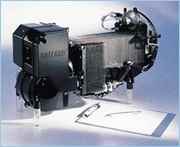Fuel CellsFuel cells are a major part of most descriptions of the hydrogen economy.
|
| Energy (Electricity) => |
(Electrolysis) |
=> Hydrogen |
| Water => | => Oxygen |
Here is a picture of what a fuel cell does. Reversing electrolysis is extraordinarily difficult. Efficiency depends on many factors.
| Hydrogen => |
Fuel Cell |
=> Energy (Electricity) |
| Oxygen => | => Water |
There are many kinds of fuel cells. Some are expensive because they require a platinum catalyst. Some are not useful for transportation because they operate at very high temperatures. [2]
Alkaline fuel cells (AFC) are efficient at 60% and they are light in weight but short lived. Because they are easily damaged by atmospheric carbon dioxide, expensive purified hydrogen and oxygen must be provided. They are potentially economical because they do not require an expensive catalyst. An AFC went to the moon with the Apollo astronauts.
The phosphoric acid fuel cell (PAFC) is the most mature technology. PAFCs use a platinum catalyst which is easily poisoned by carbon monoxide. The efficiency, at 37% to 42%, is not much better than a diesel. PAFCs cost about $4,000 per kilowatt which translates to $300,000 for enough to power a small car.
Molten carbonate and solid oxide fuel cells operate at very high temperatures. They are not easily started and stopped. They have the potential to convert coal or natural gas into electricity with efficiencies exceeding current methods. They are not suitable for transportation.
The proton exchange membrane (PEM) fuel cell offers high power density and light weight and therefore they are suitable for transportation. They operate on hydrogen and air, although the hydrogen must be very pure to avoid damage to the catalyst. PEMs are expensive because they use platinum catalyst.
Ballard Power Systems located near Vancouver, Canada, is world's largest manufacture of fuel cells and fuel cell related components. [3] They have other operations in the United States and Germany and customers around the world. Ballard had revenue of $119.6 million and losses of $125.1 million for the year 2003. Patient investors hope that Ballard will play a large role in the coming hydrogen economy.
Ballard manufactures proton exchange membrane (PEM) fuel cell modules, complete fuel cell engines, electric drives, and power electronics products. These are offered to original equipment manufacturers (OEMs) in the transportation business.
 Ballard
manufactures this electrical power source. It consumes hydrogen and air
while generating 1200 watts. It weighs 29 pounds. It is quiet and it
produces only water during operation. Its rated life is 9 weeks of
continuous operation, which may limit applications. In any case you cannot
buy it; it is only available to OEMs. Since it uses a platinum catalyst,
it is probably expensive.
Ballard
manufactures this electrical power source. It consumes hydrogen and air
while generating 1200 watts. It weighs 29 pounds. It is quiet and it
produces only water during operation. Its rated life is 9 weeks of
continuous operation, which may limit applications. In any case you cannot
buy it; it is only available to OEMs. Since it uses a platinum catalyst,
it is probably expensive.
 Ballard
also manufactures this engine designed to be incorporated into a European
transit bus. PEM fuel cells and a 255 horsepower electric motor are
integrated in a 4780 pound unit. The efficiency is given as 35% to 45% on
an LHV basis. The efficiency decreases as power output increases. This is
opposite of diesel or gasoline engines.
Ballard
also manufactures this engine designed to be incorporated into a European
transit bus. PEM fuel cells and a 255 horsepower electric motor are
integrated in a 4780 pound unit. The efficiency is given as 35% to 45% on
an LHV basis. The efficiency decreases as power output increases. This is
opposite of diesel or gasoline engines.
It is possible to estimate the overall efficiency of a real hydrogen powered bus using the information provided here. The size and pressure of the hydrogen storage tanks is not provided. The busses would have short range with low pressure tanks, but energy lost compressing hydrogen could be reduced to, say, 5% in this way. The overall efficiency is the product of;
(electrolysis efficiency) X (compression efficiency) X (Ballard unit efficiency) = 25% to 32.5%
A diesel engine has better efficiency, especially at highway speeds. The Ballard unit is heavy as are the compressed hydrogen tanks, further reducing efficiency. It is true that the Ballard unit emits only water, but that ignores the emissions arising from electricity generation. Propane, or methane, even desulfurised diesel could power a conventional bus with greatly reduced emissions.
HHV (High Heating Value) and LHV (Low Heating Value) are engineering terms used since the 19th century. The LHV number usually is more realistic. Heat energy lost out the tailpipe or up the chimney is not easily recoverable, especially on a vehicle. This chart compares HHV and LHV values for several fuels. Notice that the difference is greater for hydrogen. Ballard used the LHV value in calculating the efficiency of their engine which made it look better. Ballard stands on firm engineering ground in so doing. Any device that makes hydrogen will look worse if LHV numbers are used to calculate efficiency. The error lies in mixing LHV and HHV numbers inconsistently.
| HHV | LHV | Difference | |
| Hydrogen | 142 MJ/kg | 120 MJ/kg | 18% |
| Natural Gas | 38 MJ/kg | 35 MJ/kg | 8% |
| Gasoline | 35 MJ/kg | 32 MJ/kg | 11% |
![]()
[1] http://en.wikipedia.org/wiki/Electrolysis_of_water How to make elemental hydrogen.
[2] http://www.eere.energy.gov/hydrogenandfuelcells/fuelcells/ A useful site. There is a tendency to accentuate the positive about hydrogen.
[3] http://www.ballard.com/ Ballard Power System's website.
http://manila.servlet.net/fuelcellfolly/ Fuel Cell Folly, the Whole Story is the title of this well organized site. It describes and critiques the hydrogen economy idea. Very well researched.